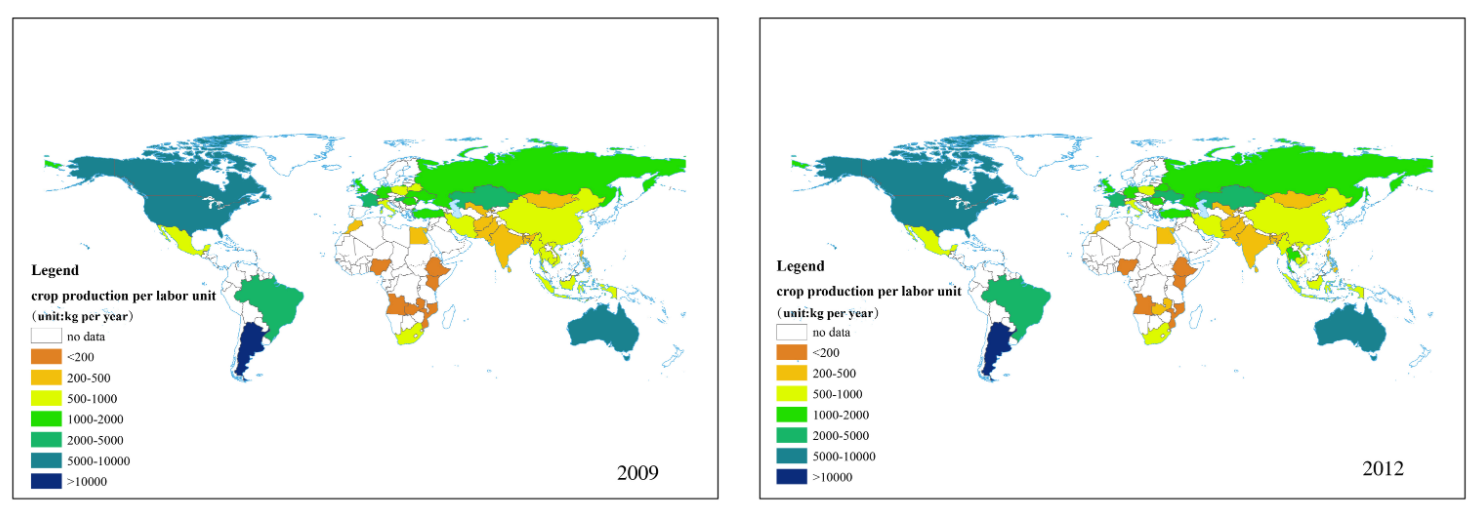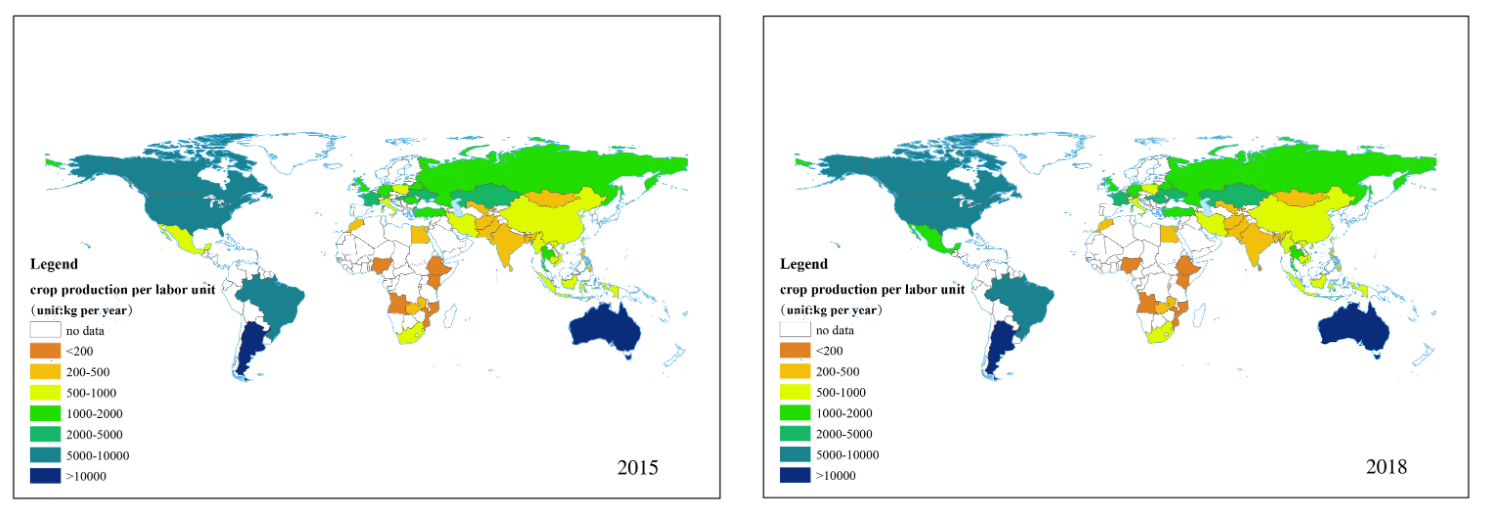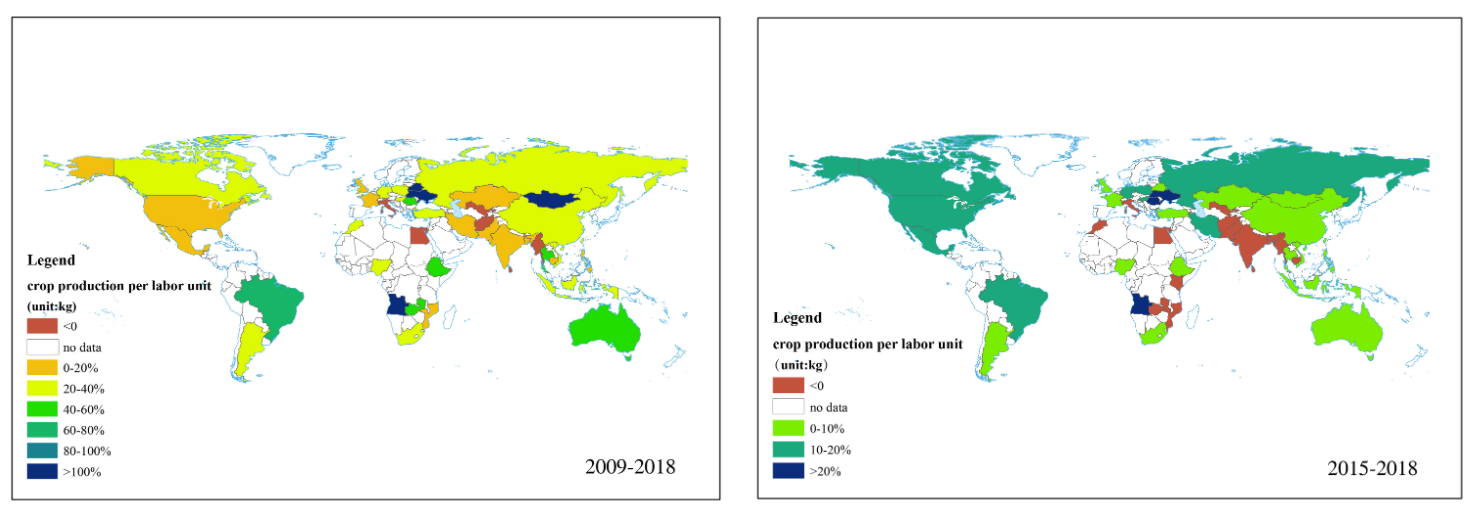SDG2: Zero Hunger
Global crop production per labor unit assessment based on Big Earth Data(2019)
Scale: Global
Study area: Global
The primary task of achieving zero hunger and eradicating poverty is to ensure adequate food, and one important means to ensure adequate food is to improve agricultural productivity. The production from small-scale farming operations is easily affected by agro-meteorological conditions, irrigation levels, pesticide and fertilizer use, and field management. Therefore the food production per labor unit of small farms is lower than that of large-scale grain producers, especially for rainfed crops, and yields from these small-scale operations have very high fluctuations. Utilizing the crop yield monitoring model of the Global Agriculture Monitoring Cloud Platform (CropWatch) system, coupled with population data, the crop production per labor unit can be quickly estimated, which can be of critical importance for the agricultural services of many countries. The system supports the decision-making process by provisioning timely information that is essential for achieving the goal of zero hunger.
Target 2.3: By 2030, double the agricultural productivity and incomes of small-scale food producers, in particular women, indigenous peoples, family farmers, pastoralists, and fishers, including through secure and equal access to land, other productive resources and inputs, knowledge, financial services, markets, and opportunities for value addition and non-farm employment.
Indicator 2.3.1: Volume of production per labor unit by classes of farming/pastoral/forestry enterprise size.
Method
Aiming at SDG 2, the methodology for this study estimates the production of staple grain and oil crops such as wheat, rice, corn, and soybeans by utilizing multi-source data including: crop yield information from remote sensing monitoring models; crop yields from agro-meteorological stations and meteorological data from ground observation stations; national agricultural population data from national census databases; and crop sample data from crowdsourced data resources. Currently the monitoring of crop production per labor unit for 42 major food producing and exporting countries has been calculated from 2009 to 2018.
Data used in the case
Remote sensing data and related products include HJ-1A/B, GF-1, GF-2, ZY-3, Sentinel-1, Sentinel-2, Landsat 8, Moderate Resolution Imaging Spectroradiometer (MODIS), Tropical Rainfall Measuring Mission satellite (TRMM), and Project for On-Board Autonomy-Vegetation (PROBA-V). Statistical data includes national agricultural population data of major global food producing countries. Ground survey data includes yield data from agro-meteorological stations, management information such as fertilization, and crop sample data based on crowdsourced data collection.
Results and analysis


Figure 1. Spatial distribution of global crop production per labor unit from 2009 to 2018.

Figure 2. Spatial distribution of changes in different periods of global crop production per labor unit.
The trend of global crop production per labor unit from 2009 to 2018 has been rising gradually with a total increase of 34% at an average annual growth rate of 3.8%. Compared with 2015, the year marks the end of the UN Millennium Development Goals (MDGs) and provides the baseline of the SDGs, global crop production per labor unit increased by 10% in 2018, with an average annual growth rate of 3.5%. This suggests that global crop production is becoming more efficient. Overall, food security pressures have reduced to some degree; however, there is still a large gap from the goal of doubling agricultural productivity in 2030 set in the SDGs.
Crop production per labor unit in Africa and Asia is generally lower than in North America, Oceania, Europe and South America. This is mainly a product of differences in farmland management practices. Developed countries adopt large- scale, intensive farm management and precise agricultural management methods, through a high level of agricultural mechanization. All of these factors make crop production per labor unit in developed countries tens of times higher than that of developing countries. However, crop production in developing countries is growing at a faster rate, and the countries that have doubled their crop production per labor unit in the past 10 years are all developing countries.
From 2009 to 2018, countries with rapid growth in global crop production per labor unit include Angola, Mongolia, Ukraine, and Belarus, all of which are countries along the Belt and Road. Ukraine in particular has a strong growth trend and has maintained sustained and rapid growth. The countries with negative growth include Italy, Sri Lanka, Myanmar, Egypt, Kenya, and other countries in the African continent, most of which have a fluctuating crop production per labor unit with a declining trend. The growth rate of crop production per labor unit in China is close to the global average, which is between 30-40%. Closing gaps in crop production per labor unit by advancing agricultural management techniques and level of agricultural mechanization in appropriate regions is therefore critical to achieve the target of doubling agricultural productivity and income by 2030.

Figure 3. A joint field investigation of wheat yield in Ethiopia.
| Highlights |
| Global crop production per labor unit increased by 10% from 2015 to 2018, and the global crop production system is becoming more efficient. Crop production per labor unit in developed countries is tens of times higher than that of developing countries. However, developing countries enjoy a faster growth rate. Closing gaps in labor productivity by advancing agricultural management techniques and level of agricultural mechanization in appropriate regions is therefore critical to achieve the target of doubling agricultural productivity and income by 2030. |
Outlook
For technological innovation, it is recommended to optimize crop yield monitoring based on the CropWatch system and further bring in information on the agricultural climate and planting structure at different scales. At the same time, it is important to carry out a coupling analysis of the trend of crop production per labor unit by integrating national socioeconomic data, such as per capita income and farm management measures. On the other hand, it is important to strengthen the cloud computing capacity of the CropWatch system to improve data processing and analysis of global crop yields.
For application promotion, under the support of the Digital Belt and Road Program (DBAR), participants have realized the customization and system migration of the CropWatch cloud platform in Mozambique first, helping Mozambique to grasp the agricultural monitoring technology. Participants will carry out the promotion and application of monitoring technologies in other countries and regions along the Belt and Road, and improve the accuracy of agricultural monitoring in countries and regions along the Belt and Road and provide technical support for achieving SDG 2.3.

